Norma Verticalis
Question 1. Anterior fontanelle.
Answer:
Coronal suture:
- This is placed between frontal Lone and the two parietal bones
Sagittal suture:
- It is placed between two parietal bone
Read And Learn More: BDS Previous Examination Question And Answers
Significance:
- It closes at 18 months of age
- It allows growth of brain
- If fontanelles fuse early, brain growth is stunted
- If anterior fontanelle is bulging, there is raised intracranial pressure
- If fontanelle is depressed, it shows decreased intracranial pressure
- This indicates dehydration
- During parturition, it helps to determine the position of vertex
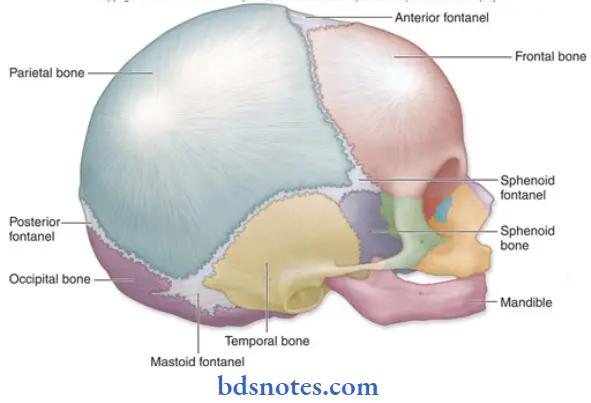
Question 2. Metopic suture
Answer:
- It has a rare occurrence
Site:
- It lies in the median plane
- It separates the two halves of the frontal bone
Incidence:
- This is occasionally present in about 3-8 % individuals
Question 3. Name the bones meeting at bregma
Answer:
- Two parietal bones and
- Frontal bone and
Question 4. Anterior fontanelle.
Answer:
Coronal suture:
- This is placed between frontal bone and the two parietal
bones Sagittal suture:
- It is placed between two parietal bone
Anterior fontanelle:
- It is a meeting point between the coronal and sagittal suture
Norma Occipitalis
Question 1. External occipital protuberance
Answer:
Site:
- It is an median prominence in the lower part of norma occipitalis
Significance:
- It marks the junction of the head and neck
- The most prontinent part of it is inion
- It is easily felt at the point where the back of the neck becomes continuous with the scalp
Attachments:
- Upper part
- Gives origin to the trapezius
Lower part:
- Gives attachment to the upper end of the ligamentum nuchae.
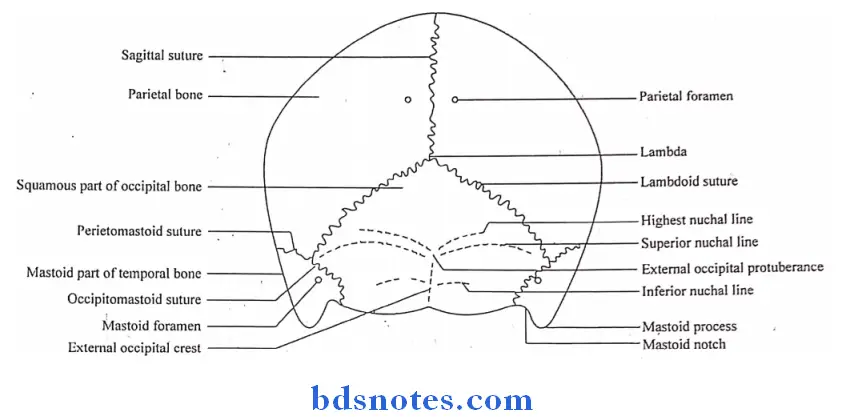
Question 2. Superior nuchal lines
Answer:
- They are curved bony ridged passing laterally from the external occipital protuberance
Attachments:
- Medial one-third: gives origin to trapezius
- Lateral part: provides insertion to sternocleidomastoid above and splenius capitis below
Question 3. Superciliary arch
Answer:
Location & Appearance:
- It is a rounded, curved elevation situated just above the medial part of each orbit
- Prominent in males
Attachments:
- Medial part: gives origin to corrugators supercilli
Normal Lateralis
Question 1. Mastoid process.
Answer:
- It is nipple-like large projection from the lower part of the mastoid temporal bone
- It forms lateral wall of mastoid notch
Location:
- Posteroinferior to the external acoustic meatus
Occurrence:
- During 2nd year of life
Structures Present:
- Tympanomastoid fissure: on the anterior aspect of the base of mastoid process
- Mastoid foramen: at near occipitomastoid suture
Structures Attached:
- Sternocleidomastoid, splenius capitus & longissimus capitus inserted from before backwards on posterior part of lateral surface of mastoid process
- Posterior belly of digastrics – from mastoid notch
Relations:
1. Tympanomastoid fissure
- Transmits auricular branch of vagus nerve
2. Mastoid foramen – transmits
- Emissary vein connecting the sigmoid sinus with the posterior auricular vein
- Meningeal branch of occipital artery
Question 2. Give the position, connection and branches of pterygopalatine ganglion.
Answer:
Pterygopalatine Ganglion:
Situation:
It is the largest parasympathetic ganglion
Branches:
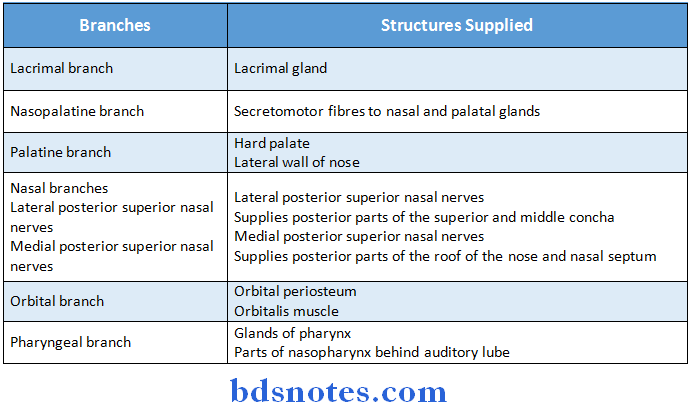
Connections:

Question 3. Zygomatic arch
Answer:
- It is horizontal bar
Location:
- Sympathetic root
Formation:
- Anterior 1/3rd: by the temporal process of zygomatic bone
- Posterior 2/3rd: by zygomatic process of temporal bone
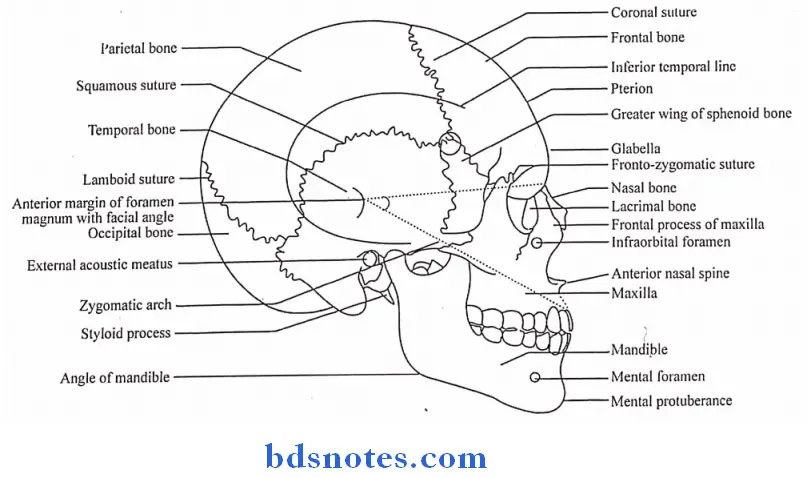
Parts:
- Jugal point: At the anterior end of upper border
- Anterior & posterior root: At the posterior end
- Articular tubercle: At the junction of anterior & posterior root
- Postglenoid tubercle: Behind the articular fossa
Attachments:
Temporal fascia: Outer & inner parts of superior border of arch
Masseter: To the medial & lower border of arch
Lateral ligament of TMJ: To tubercle of root of arch
Question 4. Pterion
Answer:
- It is H-shaped suture present in the anterior part of the floor of temporal fossa
- It is meeting point of four bones
- Frontal
- Parietal
- Greater wing of sphenoid
- Temporal
Location:
- 4 cm above the midpoint of zygoma
- 2.5 cm behind the frontozygomatic suture
Relations:
- Structures related to it are:
- Middle meningeal vein
- Anterior division of the middle meningeal artery
- Stem of the lateral sulcus of brain
Question 5. Name bones meeting at pterion
Answer:
- Frontal
- Parietal
- Greater wing of sphenoid
- Temporal
Question 6. Surgical importance of pterion
Answer:
- Pterion is the thin part of skull
- In road side accidents, the anterior division of middle meningeal artery may be ruptured leading to clot formation between the skull bone & the duramater or extradural haemorrhage
Result:
- Clot compresses the motor area of brain leading to paralysis of the opposite side
Prevention: Use of helmet
Question 7. Mastoid process
Answer:
- It is nipple-like large projection from the lower part of the mastoid temporal bone
- It forms lateral wall of mastoid notch
Location:
- Posteroinferior to the external acoustic meatus
Occurrence:
- During 2nd year of life
Structures Present:
Tympanomastoid fissure: On the anterior aspect of the base of mastoid process
Mastoid foramen: At/ near occipitomastoid suture
Structures Attached:
- Sternocleidomastoid, splenius capitus & longissimus capitus- inserted from before backwards on posterior part of lateral surface of mastoid process
- Posterior belly of digastrics – from mastoid notch
Question 8. Name muscles attached to mastoid process.
Answer:
- Sternocleidomastoid, splenius capitus & longissimus capitus- inserted from before backwards on posterior part of lateral surface of mastoid process
- Posterior belly of digastrics – from mastoid notch
Question 9. Mastoid groove
Answer:
- The mastoid part of the temporal bone lies just behind the external acoustic meatus
- It is continuous with the squamous temporal bone
- A partially obliterated squamomastoid suture may be visible just in front of & parallel to the roughened area of muscular insertions known as mastoid groove.
Question 10. Stylomastoid foramen
Answer:
Location:
- It is located posterior to the styloid process
Structures passing through it:
- Facial nerve
- Stylomastoid branch of posterior auricular foramen
Question 11. Piriform fossa/ piriform recess
Answer:
- It is a small cavity or pocket between the lateral walls of the pharynx on each side & upper part of the larynx
- It is also called Pyriform fossa or Pyriform sinus
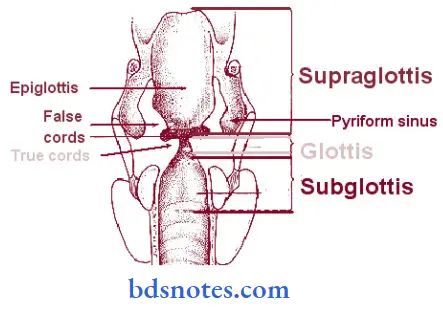
Question 12. Suprameatal triangle of McEwan’s
Answer:
- Suprameatal triangle is small depression present posteroinferior to the external auditory meatus.
- It forms the lateral wall of the tympanic or mastoid antrum.
Boundaries:
- Superior – supramastoid crest
- Anterior – posteriosuperior margin of the external auditory meatus
- Posterior – vertical tangent to the posterior margin of the meatus.
Norma Basalis
Question 1. Foramen magnum
Answer:
- Foramen magnum is largest foramen of the skull
- Opens into posterior cranial fossa-upwards and into vertebral canal- downward
- It is oval in shape
- It is overlapped on each side by the occipital condyles
Structures Passing Through It:
- Anterior part-3 structures
- Apical ligament of dens
- Vertical band of cruciate ligament
- Membrana tectoria
- Posterior part-2 structures
- Lower part of medulla oblongata
- 3 meninges
- Through subarachnoid space- 9 Structures
- Spinal accessory nerves -2
- Vertebral arteries – 2
- Sympathetic plexus around the vertebral arteries -2
- Posterior spinal arteries – 2
- Anterior spinal artery – 1
Question 2. Structures passing through foramen magnum
Answer:
- Anterior part-3 structures
- Apical ligament of dens
- Vertical band of cruciate ligament
- Membrana tectoria
- Posterior part-2 structures
- Lower part of medulla oblongata
- 3 meninges
- Through subarachnoid space-9 Structures
- Spinal accessory nerves -2
- Vertebral arteries – 2
- Sympathetic plexus around the vertebral arteries -2
- Posterior spinal arteries – 2
- Anterior spinal artery – 1
Question 3. Foramen of middle cranial fossa
Answer:
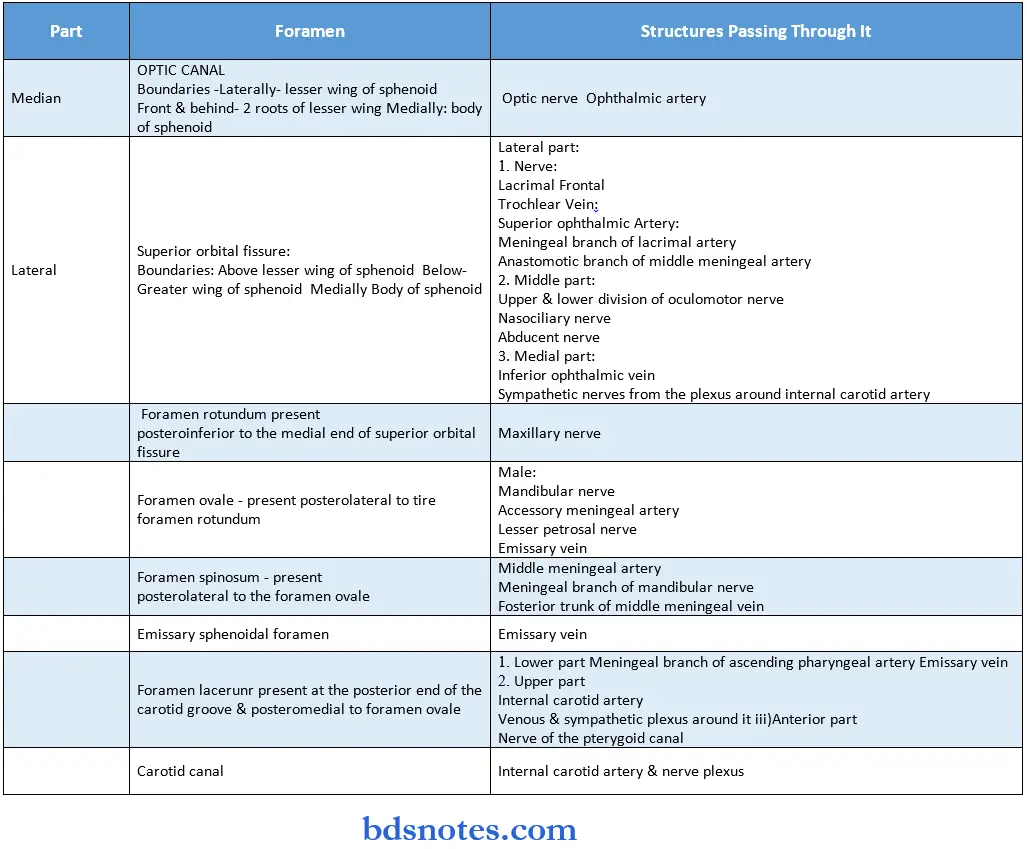
Question 4. Diploic veins
Answer:
- The diploic veins are large, thin-walled valveless veins that channel in the diploë between the inner and outer layers of the cortical bone in the skull.
- They develop fully by the age of two years.
- The diploic veins drain this area into the dural venous sinuses.
- The four major types of diploic veins found on each side of the head are frontal, anterior temporal, posterior temporal, and occipital diploic veins.
Types:

Question 5. Auditory tube
Answer:
- The auditory tube connects the middle ear with the nasopharynx anteriorly
- The sulcus tube which is a groove between the posteromedial margin of the greater wing of the sphenoid & the petrous temporal bone lodges the cartilaginous part of the auditory tube
Question 6. Pterygomaxillary fissure
Answer:
- It is a triangular interval formed by the divergence of the maxilla from the pterygoid process of the sphenoid
- It connects infratemporal with the Pterygopalatine fossa
- It transmits terminal part of internal maxillary artery
Question 7. pterygopalatine fossa.
Answer:
Location:
- Lies deep to the pterygomaxillary fissure
Boundaries:
- Anterior
- Posterior surface of maxilla
- Posterior
- Pterygoid process
- Greater wing of sphenoid
- Medial
- Perpendicular place of palatine bone
- Floor
- Union of anterior & posterior walls
Contents:
- Maxillary nerve & its branches
- 3rd part of maxillary artery & its branches
- Pterygopalatine ganglion with its branches
Question 8. Name contents of pterygopalatine fossa
Answer:
3 contents:
- Maxillary nerve & its branches
- 3rd part of maxillary artery & its branches
- Pterygopalatine ganglion with its branches
3 ganglion:
- Sphenopalatine
- Pterygopalatine
- Ganglion of hay fever
3 structures transversing in posterior wall:
- Maxillary nerve
- Nerve of pterygoid canal
- Pharyngeal branch through pterygoid canal
3 structures passing through inferior orbital fissure
- Infraorbital nerve
- Zygomatic nerve
- Orbital branches of the ganglion
3 structures through inferior opening:
- Anterior palatine nerve & greater palatine vessels
- 2 Posterior palatine nerve & lesser palatine vessels
3 structures through medial opening:
- Nasopalatine nerve & sphenopalatine vessels
- Medial posterosuperior nasal branches
- Lateral posterosuperior nasal branches
3 roots of the ganglion:
- Sensory
- Sympathetic
- Secretomotor
Question 9. Pterygopalatine ganglion
Answer:
- It is largest parasympathetic ganglion
Roots:
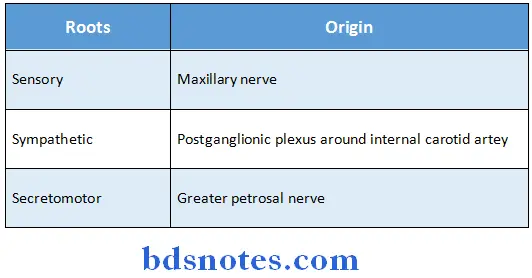
Branches:
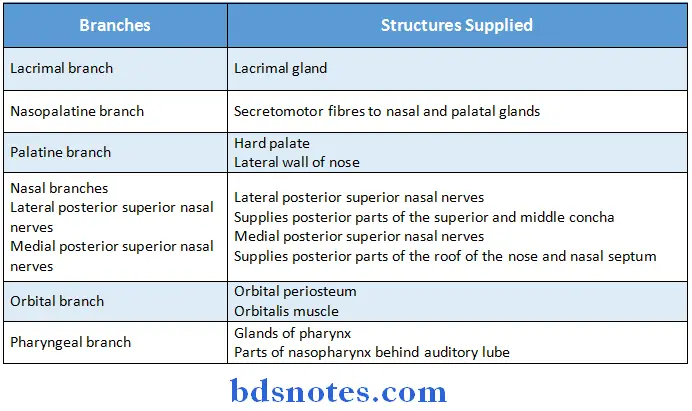
- Posteriorly, the groove leads to the bony part of the auditory tube, which lies within the petrous temporal bone
Parts:
- Osseous part-36 mm long
- Fibro-cartilaginous part-24 mm long
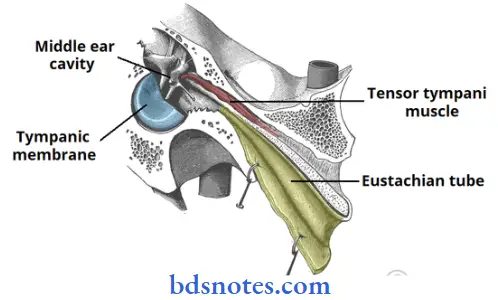
Arterial Supply:
- Middle meningeal artery
- Artery of the pterygoid canal
- Ascending pharyngeal branch of external carotid artery
Venous Drainage:
- Pterygoid & pharyngeal Venous plexus
Function:
- Maintains equilibrium of air pressure
Question 10. Foramen magnum
Answer:
- Foramen magnum is largest foramen of the skull
- Opens into posterior cranial fossa-upwards and into vertebral canal- downward
- It is oval in shape
- It is overlapped on each side by the occipital condyles
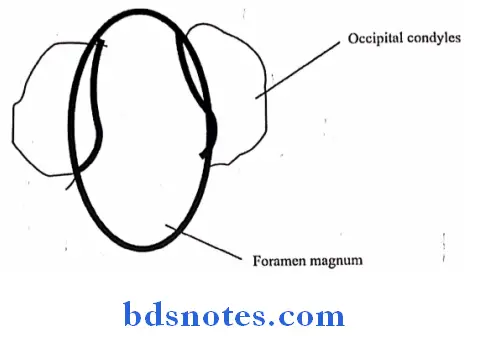
Question 11. Jugular foramen
Answer:
- It is large & elongated.
- It is placed at the posterior end of the petro-occipital suture
Structures passing through it:
- Anterior part:
- Inferior petrosal sinus
- Meningeal branch of ascending pharyngeal artery
- Middle part:
- Glossopharyngeal nerve
- Vagus nerve
- Accessory nerve
- Posterior part:
- Internal jugular vein
- Meningeal branch of occipital artery
Question 12. Foramen lacerum.
Answer:
- It is short, wide canal, 1 cm long
- Bounded by
- Posterolaterally: by apex of the petrous temporal bone
- Medially:
- Basiocciput
- Body of the sphenoid
- Anteriorly
- Root of the pterygoid process
- Greater wing of the sphenoid bone
Structures passing through it:
- Lower part
- Meningeal branch of ascending pharyngeal artery
- Emissary vein
- Upper part
- Internal carotid artery
- Venous & sympathetic plexuses around it
- Anterior part
- Nerve of the pterygoid canal
Question 13. Superior orbital fissure
Answer:
- It is situated at the posterior part of the junction between the roof & lateral wall of the orbit
- It is an oblique, roughly triangular space bounded
- Above by the lesser wing
- Below by the greater wing
- Medially by the body of the sphenoid
Structures passing through it:
- Lateral part:
- Nerves: lacrimal, frontal, trochlear
- Vein: superior ophthalmic
- Arteries: meningeal branch of lacrimal artery, anastomotic branch of middle meningeal artery
- Middle part:
- Upper & lower division of oculumotor nerve
- Nasociliary nerve
- Abducent nerve
- Medial part:
- Inferior ophthalmic vein
- Sympathetic nerves from the plexus around internal carotid artery
Question 14. Structures passing through foramen ovale
Answer:
Male:
- Mandibular nerve
- Accessory meningeal artery
- Lesser petrosal nerve
- Emissary vein
Question 15. Structures passing through foramen spinosum
Answer:
Structures passing through foramen spinosum are:
- Middle meningeal artery
- Meningeal branch of mandibular nerve
- Posterior trunk of middle meningeal vein
Question 16. Structures passing through superior orbital fissure
Answer:
- Lateral part
- Nerves: lacrimal, frontal, trochlear
- Veins: superior ophthalmic
- Arteries: meningeal branch of lacrimal artery, anastomotic branch of middle meningeal artery
- Middle part
- Upper and lower division of oculomotor nerve
- Nasociliary nerve
- Abducent nerve
- Medial part
- Inferior ophthalmic vein
- Sympathetic nerves from the plexus around internal carotid artery
Question 17. Structures passing through anterior condylar canal
Answer:
- Hypoglossal nerve
- Meningeal branch of the hypoglossal nerve
- Meningeal branch of ascending pharyngeal artery
- Emissary vein
Question 18. Foramen ovale
Answer:
- Foramen ovale is large and oval in shape
Location:
Posterolateral to the upper end of the posterior border of lateral pterygoid plate
Structures passing through it:
Male:
- Mandibular nerve
- Accessory meningeal artery
- Lesser petrosal nerve
- Emissary vein
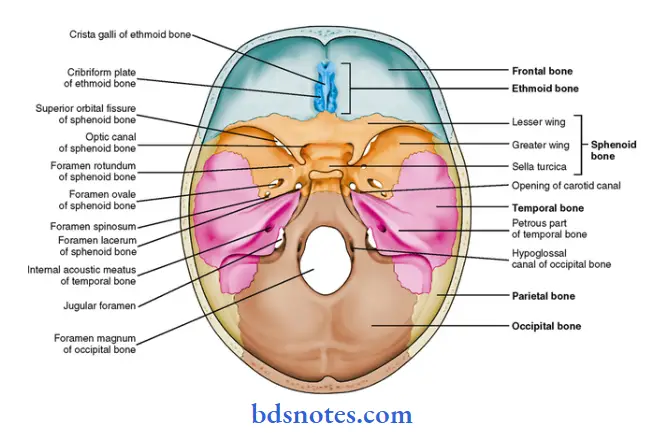
Cervical Vertebrae
Question 1. Atlanto-occipital joint
Answer:
- Altanto-occipital joint is synovial joint
Articular surfaces:
- Above-occipital condyles
- Below-superior anterior facets of the atlas vertebrae
Ligaments:
- Fibrous capsule
- Surrounds the joint
- Anterior atlanto-occipital membrane
- Extends from anterior margin of the foramen magnum to the upper border of the anterior arch of the atlas
- Posterior atlanto-occipital membrane
- Extends from posterior margin of the foramen magnum to the upper border of the posterior arch of the atlas
Arterial supply:
- Vertebral artery
Nerve supply:
- First cervical nerve
Movements:
- Flexion- around transverse axis
- Extension around transverse axis
- Lateral bending – around anteroposterior axis
Question 2. Atlanto-axial joint
Answer:
Types of joint:

Ligaments:
- Laterally
- Capsular ligament
- Lateral part of the anterior longitudinal ligament
- Ligamentum flavum
- Medially
- Loose capsular ligament
- Transverse ligament
Movements:
- Rotatory around a vertical axis
Significance:
- Cruciate ligament of median atlantoaxial joint ruptures in judicial hanging
Question 3. Dens.
Answer:
- It is the typical feature of second cervical vertebrae called axis
Appearance:
- It is strong tooth-like process projecting upwards from the body of axis
Significance:
- It represents the centrum of atlas which has fuse with centrum of axis
- Death in execution by hanging is due to dislocation of dens following rupture of transverse ligament of dens
Relations:
- Superior surface of body of axis fuses with dens
- Easch side is encroached by superior articular facets
Surfaces:
- Inferior surface: Has prominent anterior margin
- Anterior surface: Has median ridge on each side
Attachments:
Anteriorly: Articulates with anterior arch of atlas
Posteriorly: With transverse ligament of atlas
At apex: Provides attachment to apical ligament
On each side below apex: To alar ligament
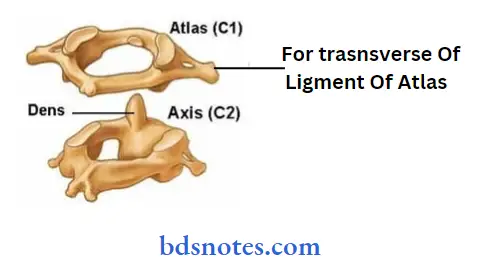
Question 4. Typical features of atlas
Answer:
- It is ring shaped
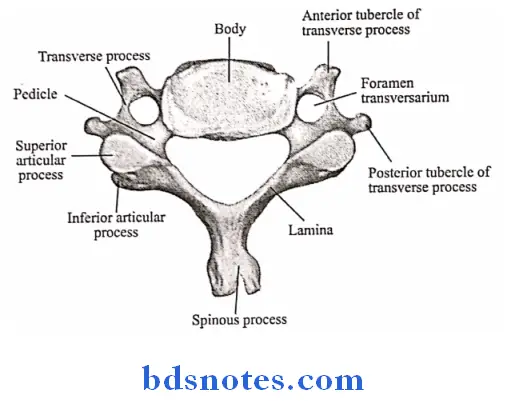
- It has following features
- Short anterior arch marked by medial anterior tubercle
- Long posterior arch forming 2/5th of the ring
- Lateral masses
- Its upper & lower surfaces bears superior articular facet & inferior articular facet
- Transverse process
- It can be felt on the surface of the neck between angle of mandible & mastoid process
Question 5. Altlanto-occipital joint
Answer:
- Altanto-occipital joint is synovial joint
Articular surfaces:
- Above occipital condyles
- Below-superior anterior facets of the atlas vertebrae.
Ligaments:
- Fibrous capsule
- Anterior atlanto-occipital membrane
- Posterior atlanto-occipital membrane
Arterial supply:
- Vertebral artery
Nerve supply:
- First cervical nerve
Movements:
- Flexion – around transverse axis
- Extension – around transverse axis
- Lateral bending – around anteroposterior axis
Question 6. Atlanto-axial joint
Answer:
- It is joint between atlas and axis vertebrae
Ligaments:
- Laterally
- Capsular ligament
- Lateral part of the anterior longitudinal ligament
- Ligamentum flavum
- Medially
- Loose capsular ligament
- Transverse ligament
Movements:
- Rotatory around a vertical axis
Question 7. Foramen transversarium
Answer:
- Foramen transversarium is specific to cervical vertebrae
- Anterior and posterior tubercles are on either side of the foramen on each tranverse process
- Anterior tubercle on sixth vertebrae is called carotid tubercle
- It separates carotid artery from vertebral artery
Relations:
- Foramen transversarium transmits
- Vertebral artery
- Vertebral veins
- Branch from the inferior cervical ganglion
- Anterior tubercle gives origin to
- Scalenus anterior
- Longus capitis
- Oblique part of longus colli
- Posterior tubercle gives origin to
- Scalenus medius
- Scalenus posterior
- Levator scapulae
- Splenius cervicis
- Longissimus cervicis
- Iliocostalis cervicis
Question 6. Features of axis vertebrae
Answer:
- Axis is the second cervical vertebra
- It is identified by dens or odontoid process, typical feature of it
Surfaces:
- Superior surface of body – fused with dens
- Inferior surface – Has prominent anterior margin, Presents inferior vertebral notch
- Anterior surface – has median ridge on each side
Features:
- Pedicle – overlapped by superior articular processes
- Laminae – thick and strong
- Articular facets – large, flat and circular, overhangs foramen transversarium
- Transverse processes – very small
- Spine- large, thick and very strong
Maxilla
Question 1. Maxilla
Answer:
- It is second largest bone of the face
- It is paired bone
- It contributes in the formation of face, nose, mouth, orbit, infratemporal and pterygopalatine fossa
Features:
- It is pyramidal in shape
- Apex is directed medially & base directed laterally
Surfaces:
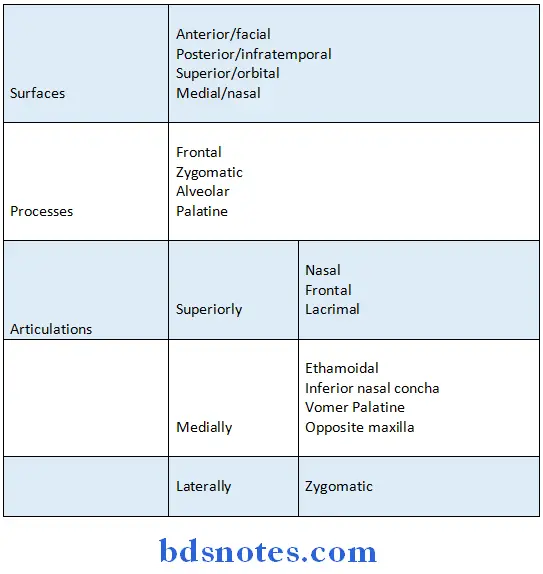
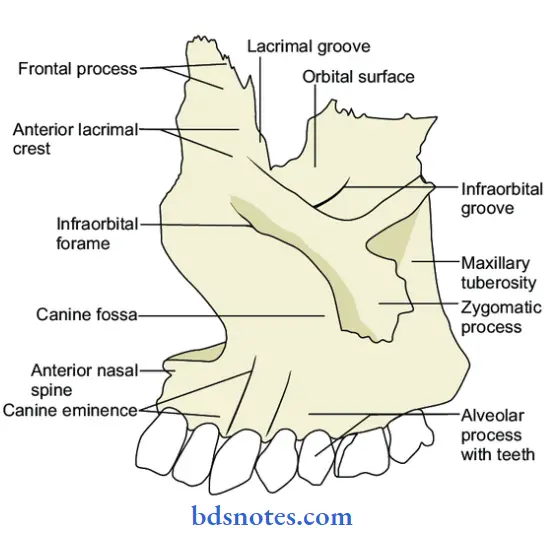
Hyoid Bone
Question 1. Hyoid bone- general features, attachments and development
Answer:
General features:
- It is U-shaped bone
- Location
- In the anterior midline of the neck between the chin and thyroid cartilage
Parts:
- Body-central part
- Has anterior and posterior surfaces
- Has upper and lower borders
- Greater cornua
- Flattened from above downwards
- Has upper and lower surfaces, medial and lateral border and a tubercle
- Lesser cornua
- These are small conical pieces of bone projecting from junction of the body and greater cornua
Attachments:
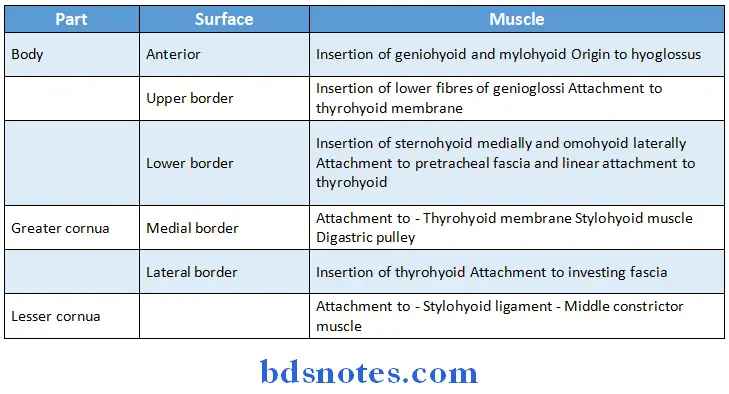
Development:

Question 2. Hyoid bone
Answer:
- It is U-shaped bone
Location:
- In the anterior midline of the neck between the chin and thyroid cartilage
Parts:
- Body- central part
- Greater cornua
- Lesser cornua
Development:

Question 3. Muscles attached to hyoid bone
Answer:
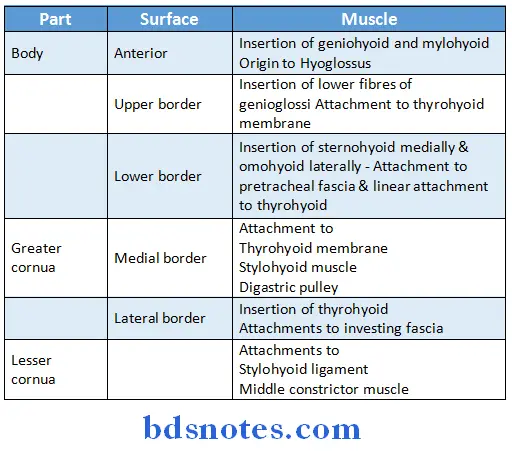
Question 4. Body of hyoid bone
Answer:
- It is central part of hyoid bone
- Has anterior and posterior surfaces
- Has upper and lower borders
Attachments:
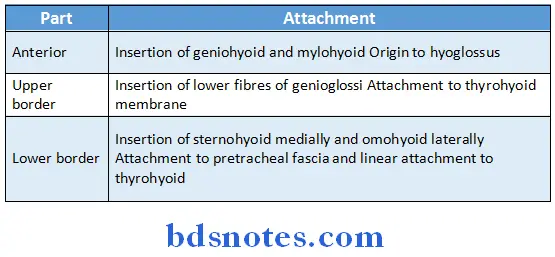
Mandible
Question 1. Ramus of mandible
Answer:
- It is quadrilateral in shape
- It extends vertically upwards from posterior part of body
Surfaces:
- Lateral
- It is flat & bears a number of oblique ridges
- Medial
- It presents mandibular foramen which leads to mandibular canal
- Anterior margin of it contains tongue shaped projection called lingula
- Mylohyoid groove begins just below mandibular foramen
Borders:
1. Upper border
- It is thin & curved downwards
- It contains condylar and coronoid process
- Mandibular notch lies between them
- Condylar process
- Its upper expanded part called head joins with fossa of temporal bone to form temporomandibular joint
- Constriction below it is called neck
- Its anterior end presents a depression called the pterygoid fovea
- Coronoid process
- It is flat triangular upward projection
2. Lower border
- It is continuous with base of mandible
- Junction between lower & posterior border forms angle of mandible
3. Anterior border
- It is thin
4. Posterior border
- It is thick
Attachments:
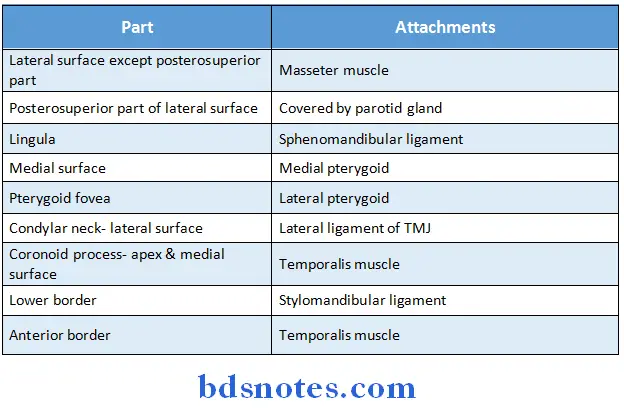
Question 2. Relations of ramus of mandible
Answer:
Muscles Related to Ramus of Mandible:
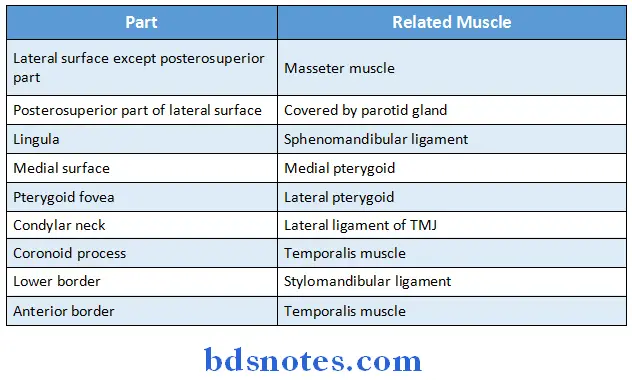
Nerves related to ramus of mandible:
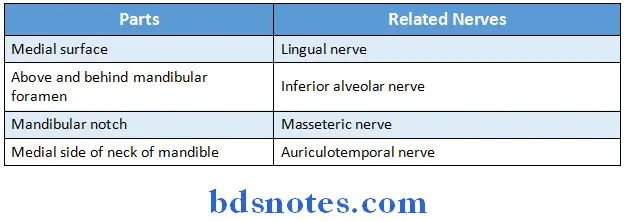
Vessels Related to Ramus of Mandible:
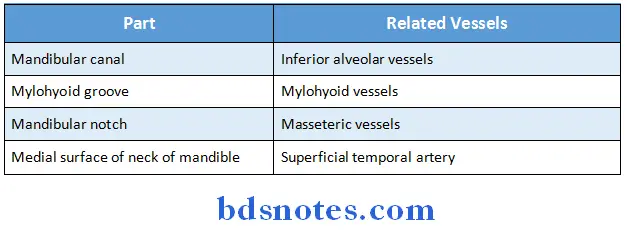
Question 3. Pterygomandibular raphe
Answer:
- It is ligamentous band of the buccopharyngeal fascia
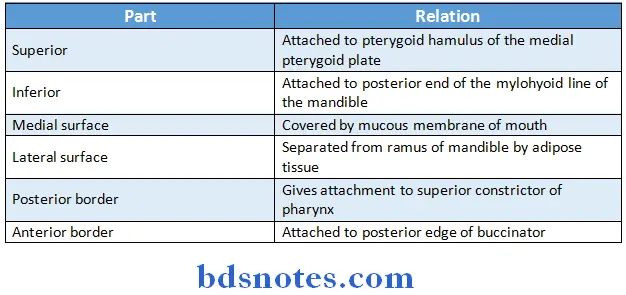
Question 4. Ligaments of mandible
Answer:
1. Sphenomandibular ligament
Location:
- It lies on the deep plane away from the fibrous capsule of TMJ
Attachments:
- Superiorly to the spine of sphenoid
- Inferiorly to the lingula of mandibular foramen
2. Stylomandibular ligament
Extend:
- From lateral surface of the styloid process of temporal bone
- Up to angle and adjacent parts of posterior border of the ramus of mandible
Question 5. Name four arteries related to the ramus of the mandible
Answer:
- Maxillary artery
- Superior temporal artery
- Massetric artery
- Inferior alveolar artery
- Mylohyoid artery
- Mental artery
- Facial artery
Question 6. Name the attachments of pterygomandibular raphe
Answer:
The pterygomandibular raphe is attached immediately behind the third molar tooth in continuation with the origin of the superior constrictor
- Muscles attached to it are:
- Superior constrictor muscle of pharynx
- The buccinator muscle
Question 7. Ligaments attached to the surface of mandible
Answer:
- Sphenomandibular ligament
- Lateral ligament of temporomandibular joint
Question 8. Stylomandibular ligament
Answer:
- It is accessory ligament of temporomandibular joint
- It is derived from investing layer of deep cervical fascia
Extend:
- From lateral surface of the styloid process of temporal bone
- Up to angle & adjacent parts of posterior border of the ramus of mandible
Question 9. Sphenomandibular ligament
Answer:
- It is accessory ligament of TMJ
- It is remnant of dorsal part of Meckel’s cartilage
Location:
- It lies on a deep plane away from the fibrous capsule of TMJ
Attachments:
- Superiorly: To the spine of sphenoid
- Inferiorly: To the lingua of mandibular foramen
Relations: It is related
- Laterally to
- Lateral pterygoid muscle
- Auriculotemporal nerve
- Maxillary artery
- Medially to
- Chorda tympani nerve
- Wall of pharynx
Question 10. Significance of Pyriform fossa
Answer:
- Pyriform fossa lies between quadrate membrane & medial side of thyroid cartilage
- It is transverse by internal laryngeal nerve
- It is used to smuggle out precious stones, diamonds, etc
- Thus it is called smuggler’s fossa
- Tumours in it causes dysphagia
Question 11. Name the bones ossified in the membrane
Answer:
- Frontal Parietal
- Temporal
- Mandible
- Palatine
- Nasal
- Vomer
- Zygomatic
- Maxilla
Question 12. Name different types of sutural joints
Answer:
- Based on the structure of their articular surfaces, there are 5 types of sutural joints:
- Plane suture
- Squamous suture
- Serrate suture
- Denticulate suture
- Schindylesis
Question 13. Laws of ossification
Answer:
Ossification occurs by two processes
1. Endochondrial ossification
- It involves cartilage as precursor
- Example: healing of fractures treated with plaster of Paris
2. Intramembranous ossification
- It is direct laying down of bone into the primitive connective tissue
- Example: healing of fractures treated with open reduction and internal fixation
Question 14. 4 nerves related to mandible.
Answer:
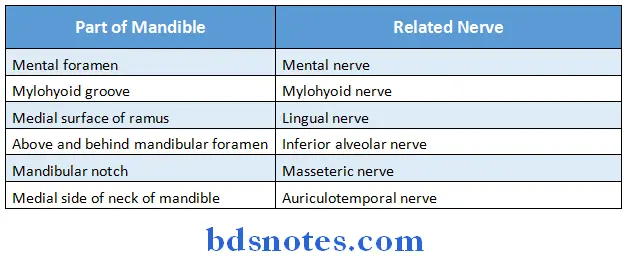
Question 15. Name any four muscles attached to ramus of mandible.
Answer:

Leave a Reply